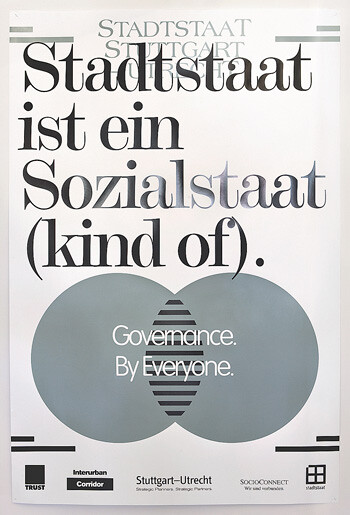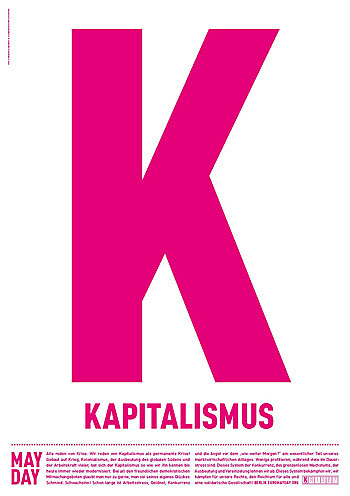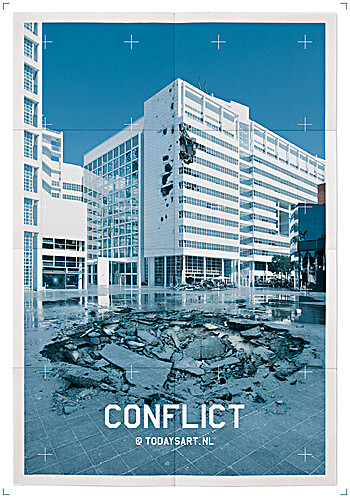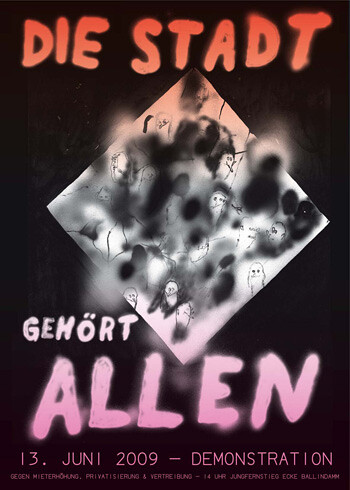Our cities have become key arenas in a primarily market-driven globalization process, a process that primarily unfolds in circumstances and at the mercy of protagonists with little or nothing to do with planning and design. The sweeping decisions of multinational companies, individual consumer preferences, ecological disasters, international politics, cultural differences, and other phenomena associated with globalization render very unrealistic the idea that collective action or even design might be able to steer urban development. Cities are widely regarded as “non-planable” entities that can be observed but only barely influenced, let alone designed. Both an urban politics perspective and design as an intentional and political practice are menaced not only by neoliberal and neoconservative forces but also by the “post-planning” approach taken by progressive planners and urban researchers. In such an approach, criticism of urban inequalities or injustice is interpreted as the failure to grasp the complexity of contemporary urban landscapes—an argument supporting the current de-politicization of the city by private companies and neoliberal government policies.1
The law of supply and demand has become the primary force in urban development, blocking any urban policy. Particularly in the urban context, this leads to a post-political situation, in which spaces of democratic engagement are swallowed up by an ongoing radical economization and de-politicization of social space—a process that does not seem to have been interrupted by the current global economic crisis. Even though it is still unclear whether the crisis serves to accelerate or modify these tendencies, it is necessary to discuss how the crisis of neoliberal ideology may simultaneously be an opportunity to imagine urban concepts that challenge the primacy of economic maneuvers.
From being strategic sites for the implementation of neoliberal policy, cities may possibly become a new political arena for experiments in democracy—and thus require a new design. Designers continue to hold back with criticism and proposals, but the time has come to redefine the role of design in a social city—and to take action. Design in the context of cities could redefine itself as a search for an alternative urban practice, beyond the techniques and the ideology of crisis-ridden, late-capitalist urbanism. For it is precisely in the field of design, which has hitherto seen only a cautious approach to urban issues, that one finds unexplored potential for an intentional (re)design of space.


Post-Political Cities
Premised on a substantive retreat of the state and the surrender of social interests to market forces,2 the constitution of cities have become strategic spaces for the implementation of neoliberal logic.3 Cities are not just victims of a takeover but are at the same time actors, since neoliberalism as a practice is embedded in the urban context; it always takes place in national, regional, or local contexts and relies on their respective institutional and political parameters, local regulatory practices, and political controversy. This context-relatedness also explains, for example, the “revival of the local” that occurs at the very moment when allegedly uncontrollable supra-national transformations are underway.4
But the radical market orientation of local neoliberal arrangements, which mark the local as a place of politics, generally develops alongside the Foucauldian concept of governmentality as a technique of governance. This regulatory practice replaces social conflict and protest with technocratic techniques that promote unanimity and consensus. Oriented to principles of economic efficiency, power legitimizes itself through the self-responsibility of those acting within the parameters of this post-Fordist form of urban government. Given the ubiquitous demand to exploit the individual as a resource, the difference between techniques of the self and techniques of dominance becomes blurred. Particularly in the urban context, this leads to a post-political, post-democratic situation, in which spaces of democratic engagement, which could resist and tackle neoliberal demands, are swallowed up.5
Belgian philosopher Chantal Mouffe defines the political as the antagonistic dimension, which is to be regarded as constitutive of society.6 Mouffe analyzes how, on the contrary, contemporary Western political models negate the potential of conflict and opposition by seeking to attain a morally construed consensus. They deny the existence of social power relations and conflicts and thus close the political arena. Like Jacques Rancière, Mouffe sees in this a “post-political” or “post-democratic” moment.7 Every contradiction, claims Mouffe, is thereby expelled from this arena and categorically excluded. For Mouffe, the major obstacle to democratic politics, that is, to politics based on conflict and contradiction, lies particularly in neoliberalism’s self-image: its fundamental assertion that there is no alternative to the existing order.8 She calls for a “common symbolic space”9 that would facilitate confrontation. To create such a space would be a design task in the widest possible sense of the term.


Beyond the Hyperliberal Disaster
Cities today are no longer seen as comprising only buildings, streets, squares, and parks. Text and images in public space, branding campaigns, street art, guidance systems, temporary installations, processual and interactive design, and cartographic illustrations influence our use, experience, and perception of the city, as do signage, urban furnishings, vehicles, infrastructures, and the appearance of public façades. The term “Environmental Graphic Design” has established itself in this field to denote a universal design at the interface of the disciplines of architecture, graphic design, product design, and urban planning. Originally coined in order to convey the new complexity of urban mega-structures, it has come to be used at almost all levels of urban design. Graphic design, for example, now substantially shapes not only the visible surfaces of a city but also its infrastructure and everyday life.
Such discursive and symbolic representations indicate an effort to treat cities as enterprises to be governed and marketed. As phenomena to be understood in light of the escalating crisis of neoliberalism, the emerging design practices in question have until now been almost exclusively top-down strategies to further control and commercialize urban spaces. They developed effective tools for the production of space, capable of being employed more rapidly, flexibly, and openly, and with greater attention to detail than urban planning and architecture. The proliferation of visual-communications strategies in urban spaces is both a characteristic of the neoliberal city as well as a set of potential tools with which to transcend it.
A search for a new, idealistic design practice will refer to this potential, if it does not simply seek to re-implement the heroic perspective of “master plan” programs at all levels of society and will not support the contemporary euphoria about individualistic urban dynamics driven solely by profit prospects. The crisis of the contemporary city can no longer be handled only with the classic tools of large-scale top-down planning. Social-spatial practices are too complex and heterogeneous for that, too dynamic and contradictory. Not to plan, however—a Darwinist demand that people take care of themselves; the fittest urban players thrive unchecked—is to abandon too easily the project of design. And yet new design for the city is urgently needed: for, by its very nature, a city cannot be anything but designed. It is socially produced.
Against the background of the “urban drama,” the emancipatory promise of design may well undergo concrete renewal. For, as Bruno Latour apprehended, the very vagueness of that “little word ‘design’ ” enables it to imbue reality with an ethical dimension; makes it incapable of hiding behind alleged facts while enabling it to pass (political) judgments that remain, however, always negotiable, and also to address contradictions. By referencing “the city” both as process and as the everyday—as a concrete dimension of reality—the purpose of design will be reflected anew: how would design look if it were inspired by an open, processual, micro-political, interventionist, communicative, and participatory approach that relates to everyday urban life? Would it be destined to be merely an element in the commodified colonization of social spaces, or could it be a strategic tool with a political and social character that can make an essential contribution to a social city? Or are graphic design and the visual representation of urban issues themselves the key means by which alternative or utopian spaces may be created upon the ideological ruins of existing cities?
If design is to transcend its complacent function as a tool of urbanization in the service of private interests, the intentions of designers, as well as the potential of critical action beyond economic considerations, must be considered. The current emergence of ethically motivated attempts to redefine the paradigms of design, employing the catchwords “sustainability,” “social compatibility,” and “producer-consumer equity, generally fall short. They argue vigorously in terms of market-alignment and reflect a consumer-oriented or individualist approach, with the result that urban or social objectives—and hence also any design-political dimensions—remain off the map. In order to deal productively with this dilemma, one must necessarily challenge the self-image of the design profession. How do protagonists see themselves, and who commissions their work? What alliances are worth striving for and what role should the public and the users play? When it comes to a design for the city, which strategies, procedures, and perspectives do we need?


Designing the Post-Neoliberal City
However, a rather ill-conceived amplification of the term “design” seems to be spreading at present, and has long since abandoned any pretense to autonomy in the face of market forces. Art critic Hal Foster—echoing for example Gert Selle’s critique of the ideological function of design—criticized how representation of the seamless transition from production to consumption is currently held to be design’s primary task. To cater to the market in this way is also what justifies design’s new and growing significance.10 Foster notes an inflation of design, which has become an agent of the out-and-out consumer society. The individualization of consumption and the creation of niche markets lead to an incessant (re)profiling of products. Dominated by the media economy, this permanent manipulation of products and their representation—design, redesign, and perpetual consumption—constitutes a perfect, unending cycle, a consumerist loop “without much ‘running-room’ for anything else.”11 Would it be possible to create or at least enable such a space by design, by exactly this discipline that seems to squeeze it tighter and tighter?
Likewise, American author Mike Davis evokes “a future in which designers are just the hireling imagineers of elite, alternative existences,” but nonetheless makes a consciously optimistic demand for utopian thinking and action.12 He connects planetary environmental disaster—irreversible, in his opinion—with massively expanding global socioeconomic injustice, and posits that both are encouraged by the worldwide economic crisis. Davis focuses on the town: even as rapidly progressing worldwide urbanization has to be seen as one of the primary causes of these problematic developments, it can also suggest a way toward their solution. He confronts the very realistic scenario of segregated zones of abundance in an otherwise economically and ecologically disastrous environment with his ideal picture of the city. In an updating of the Utopian-ecological urban criticism of the socialists and anarchists of the early twentieth century and the social experiments of the early modern age (in particular those of the socialist town concepts of the Soviet Constructivists) lies for him a starting point from which to invent cities based on democratic communal thinking. The environmental efficiency of urban density and the necessity of efficient collectivity in urban systems form the alternative to the dominant suburban-sprawl paradigm and its negative ecological and social effects. Davis sees a close connection between social responsibility and environmental responsibility, between municipal disposition and an ecological urbanism, and connects social and economic issues with pressing environmental problems. An environmentally friendly town would hence be based on relatively few new technologies of ecological town planning and prioritize general prosperity and generosity over privately accumulated wealth. The collective character of a town and its infrastructure offer the potential for overcoming the looming social and ecological disaster. To create sustainable town models requires for Davis “a vast stage for the imagination” and “a radical willingness to think beyond the horizon of neo-liberal capitalism.”13


Whether pessimistically or optimistically, it is at least interesting to note that design is again on the agenda in urban and political theory. Mouffe refers vaguely to design as a political tool for the construction of a common space, and Foster laments the lack of room for alternatives, but these could also be (mis)read as pleas for the design of a “stage for the imagination,” as Davis puts it. All of them could be considered as having in mind a kind of proto-design, producing fewer solutions (and new problems), but also social situations and processes enabling social imagination, debate, and conflict.
What such a political approach to design might look like is indicated by Gui Bonsiepe, who taught at the Ulm School of Design and currently works in Argentina as a designer and theorist. He has introduced a concept of democracy that he defines as the aim of dismantling dependence in favor of real self-determination, an ideal opposing the neoliberal understanding of democracy, which he characterizes as “synonymous with the predominance of the market as an exclusive and almost sanctified institution for governing all relations within and between societies.”14 Bonsiepe argues in this context against the use of design as “a tool of domination” and calls for an emancipative practice, “resisting a harmonizing discourse that is camouflaging the contradictions.”15 In this regard close to Davis, he demands on the one hand a really non-universalistic Utopian perspective; on the other hand, Bonsiepe insists, as does Mouffe, on the articulation of conflicts as a design task and on the contradiction-relatedness of design.
The places and zones of actual contradictions are for Bonsiepe the starting points for Utopian-formative interventions. To name and articulate such conflicts and their intentional transformation is to act on the assumption that design has a social relation that aims less at the solution of problems than the critical handling and thematization of social relations and disavowals. In such a practice, the discipline’s professional actors—just as amateurs responsible for the informal and “illegitimate” practices of design—would regard the urban space as a place for discussion and make their contribution to the debate and negotiation of political issues. Especially if designers start to connect their efforts to the worldwide “Right to the City” movement, the project of accommodating conflicts by design will refer to tangible and specific social and spatial situations and become more than a rhetorical gesture. The English geographer and social theorist David Harvey, referring to Henri Lefebvre, defines the “right to the city” as a “right to change ourselves by changing the city.”16 As a common and intentional act giving new form to urban conditions experienced as repressive with regard to our ideals and necessities, this is nothing less than a fundamental challenge to design.
Bavo have pointed to “the rise of a neoliberal take on the city in which market players, together with their new ally the entrepreneurial government, have increased their grip on the production of the city – in fact adding a new chapter to the much criticized tradition of central planning and the malleable city.” Bavo: “Democracy & the Neoliberal City”, in: Urban Politics Now: Re-Imagining Democracy in the Neoliberal City, ed. BAVO (Rotterdam: NAi Publishers, 2007), 229.
See Noam Chomsky, Profit over People: Neoliberalism and Global Order (New York: Seven Stories Press, 1999).
“Cities have become key institutional arenas in and through which neoliberalism is itself evolving.” Spaces of Neoliberalism: Urban Restructuring in North America and Western Europe, ed. Neil Brenner and Nik Theodore (Oxford: Wiley-Blackwell, 2003), ix.
“In short, the new localism has become a forceful call to arms through which local (and, in some cases, national) political-economic elites are aggressively attempting to promote economic rejuvenation from below.” Ibid., v.
Erik Swyngedouw, “The Post-Political City,” in Urban Politics Now, 59.
Chantal Mouffe, On the Political (New York: Routledge, 2005), 16.
Cf. Jacques Rancière, Aesthetics and its Discontents, trans. Steve Corcoran (Cambridge and Malden, MA: Polity Press, 2009).
Mouffe, On the Political, 31.
Ibid., 52.
Hal Foster, Design and Crime: And Other Diatribes (London and New York: Verso, 2002), xiv. Cf. Gert Selle, Ideologie und Utopie des Design: Zur gesellschaftlichen Theorie der industriellen Formgebung (Cologne: M. DuMont Schauberg, 1973).
Foster, Design and Crime, 18.
Mike Davis, “Who Will Build The Ark?” New Left Review 61 (January–February 2010): 45.
Ibid.
Gui Bonsiepe, “Design and Democracy,” Design Issues 22, no. 2 (Spring 2006): 29.
Ibid. 31.
David Harvey, “The Right to the City,” New Left Review 53 (September—October 2008): 23.

